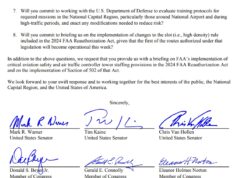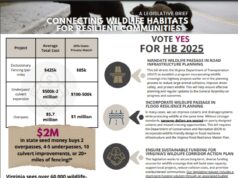Excellent news, now let’s build this thing already – it’s long past overdue.
Commonwealth to Provide Up to $65 Million in New State Funding for Columbia Pike Streetcar
July 11, 2014
*Total state funding of up to 50% of project costs
*Partnership with Arlington and Fairfax Counties
*Advances project schedule at least a year
*High-capacity streetcar will enhance northern Virginia’s economic competitiveness, generate new revenues for localities, CommonwealthARLINGTON, Va. – Virginia Transportation Secretary Aubrey Layne has notified Arlington and Fairfax County officials that the Commonwealth will increase its funding for the Columbia Pike streetcar by up to $65 million, using new funding available for fixed-guideway projects. The new funding will bring the state’s contribution to the Columbia Pike streetcar to as much as 50 percent of total design and construction costs.
“The Commonwealth is committed to supporting the Columbia Pike project as a funding partner,” Layne said in his July 10 letter to Arlington County Board Chair Jay Fisette and Fairfax County Board of Supervisors Chairman Sharon Bulova.
The State’s commitment enables Arlington to put together a financial package for the project that does not include Federal Transportation Administration New Starts funding.
Arlington and Fairfax Counties are partners in the planned Columbia Pike streetcar, which will stretch 4.9 miles from the Skyline area of Fairfax to Pentagon City in Arlington along the most heavily traveled bus corridor in the Commonwealth. The Columbia Pike streetcar, one of two segments in Arlington’s planned 7.4-mile seamless streetcar system, will support the community’s vision of transforming the Pike into a more transit-oriented, walkable Main Street.
Arlington County Board Chair Jay Fisette and Fairfax County Board of Supervisors chairman Sharon bulova wrote to Layne in June, asking that the Commonwealth consider funding the Columbia Pike streetcar project.
“This additional state funding is great news for the streetcar,” Fisette said Friday. “It is both a strong vote of confidence that the streetcar is a transit investment that will benefit the entire Commonwealth, and brings funding certainty that significantly boosts our efforts to build the Columbia Pike segment more quickly, at reduced cost.”
The state’s total contribution to the project, which will include standard transit reimbursement funding, is expected to account for up to half of the streetcar’s design and construction costs. The new grant will be split between Arlington and Fairfax, with Arlington receiving $52 million and Fairfax receiving $13 million.
“The state is making a sound transportation investment by increasing its funding for the Columbia Pike streetcar,” said Bulova. “This funding will help this important transit project get built more quickly, at a lower cost, and will help transform one of the region’s most important corridors.”
In his letter, Layne noted that “the Columbia Pike corridor currently has the highest transit ridership within the Commonwealth for a corridor without fixed-guideway service.” The streetcar project, he wrote, “provides a sound example of leveraging transportation investment to enhance economic competitiveness and provide access for residents of the DC metropolitan area to reach employment opportunities in Virginia.”
Allows project to advance more rapidly
Arlington estimates that the increased state funding will shave at least a year off the construction time for the project, allowing both jurisdictions to more quickly realize a return on investment from the streetcar. The time savings, combined with a lower escalation rate, would save an estimated $25 million.In June, Arlington signed a contract with Parsons Transportation Group to help manage the entire streetcar program. In the coming months, one of Parsons’ primary tasks will be to assess options for cost reduction by analyzing ways to deliver the streetcar sooner. This could include combining final design and construction work in a single contract or exploring potential public-private partnerships.
The latest estimated cost to build the Columbia Pike streetcar is $333 million. With the new state grant, the County Manager will recommend that Arlington cover the rest of its share through a combination of new regional transportation funding and local commercial real estate tax revenues dedicated by law solely to new transportation projects. No Arlington County homeowner-funded General Obligation bonds will be used to finance design and construction of the streetcar.
After a lengthy public process, the Arlington County Board is expected to adopt its Capital Improvement Plan, which will include the latest cost and schedule estimates for the streetcar, on July 19.
Arlington’s streetcar system
Arlington’s planned streetcar system includes the Columbia Pike segment and the Crystal City-Potomac Yard segment. The two segments will intersect at Pentagon City, where the streetcar will also connect with the regional transportation system – both Metrorail and Virginia Railway Express (VRE). The streetcars will operate along with buses to serve the growth in jobs and population expected along these corridors.Streetcar expected to generate up to $895 million in new local tax revenues
The Columbia Pike streetcar segment, based on a study released in March, is expected to generate a substantial economic and fiscal return. The study estimated that the streetcar will generate $3.2 billion to $4.4 billion in new real estate value for Arlington and Fairfax Counties over 30 years. That is over and above project capital and operating costs. The streetcar investment is also projected to generate $455-$895 million in new tax revenues for Arlington and Fairfax over a 30-year period, attract 6,600 new jobs to the corridor within 10 years of project construction and increase state income and sales taxes.Next steps
The two Counties now will work with the Department of Rail and Public Transportation (DRPT) to put together a milestone schedule that would outline the steps needed to move the project forward and execute a grant agreement with the state that will address the final amount and timing of the funding.



 Sign up for the Blue Virginia weekly newsletter
Sign up for the Blue Virginia weekly newsletter

![Rep. Don Beyer (D-VA08) on “reports of the devastating effects Donald Trump’s Project 2025 agenda would have on [Metro]”](https://bluevirginia.us/wp-content/uploads/2024/10/trumpmetro-238x178.jpg)






